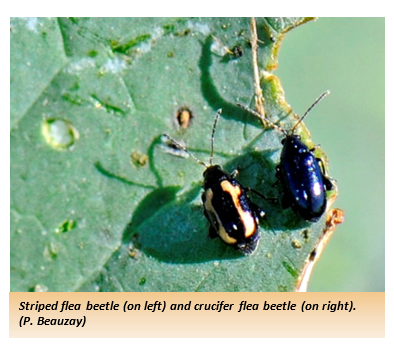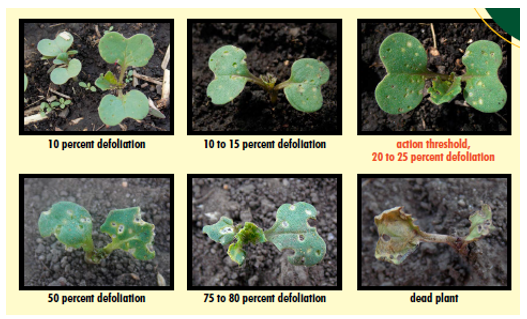Canola Flea Beetles Emerging (05/20/21)
Temperatures have warmed up above 60F and this triggers flea beetles to move out of overwintering areas to newly planted canola fields. Crucifer and striped flea beetles have been observed in overwintering shelterbelts, areas with volunteer canola or Brassicacae weeds (wild mustard), or in canola fields in the northeast (L. Lubenow, LREC) and southwest (R. Buetow, DREC). Lower numbers of flea beetles also have been observed in canola fields in the north central area near Minot (T.J. Prochaska, NCREC). The striped flea beetle typically emerges about 2 weeks earlier than the crucifer flea beetle. The first striped flea beetles were actually detected back in early May. Both species are easy to identify by their flea-like hopping behavior. The crucifer flea beetle adult is a small, oval-shaped, dark beetle with an iridescent blue sheen on the black wing covers, measuring about ⅛ inch long. The striped flea beetle adult is similar to the crucifer flea beetle in size and has two yellow stripes on its black wing covers.

Canola fields should be scouted at least biweekly during the first three weeks of emergence to ensure that the systemic insecticide seed treatments are providing ‘good’ flea beetle protection, especially during this dry year when uptake of insecticidal toxins may be slower. Continue to scout until canola is in 6-8 leaf stage when the crop can tolerate most flea beetle feeding pressure. If more than 20-25% defoliation is observed in canola fields, a foliar insecticide spray would be warranted. Pyrethroids (3A) are the only class of insecticide registered for foliar control of flea beetles in canola (active ingredients - bifenthrin, deltamethrin, gamma-cyhalothrin, lambda-cyhalothrin, zeta-cypermethrin). One premix is labeled as Besiege (chlorantraniliprole + lambda-cyhalothrin). If the 20-25% defoliation level is reached, a foliar insecticide needs to be applied as soon as possible for optimal control and to prevent yield loss.

Extension Entomologist


